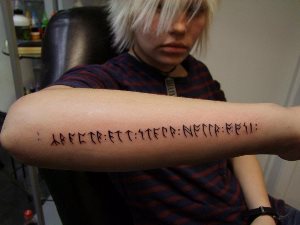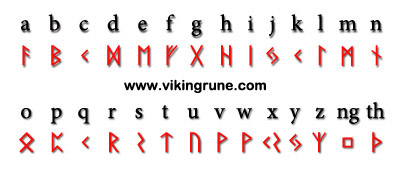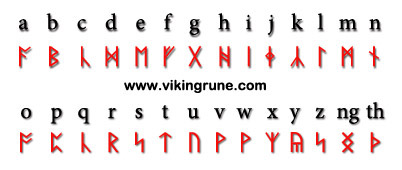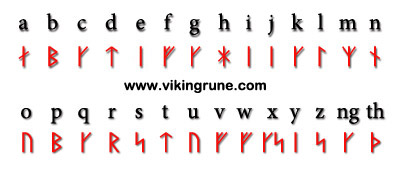 Developing a great design for a tattoo is critical in case you seriously plan to get inked. If you are about to have a Norse or Viking tattoo, I bet you want to include some Nordic runes into it. Tattooed inscriptions in foreign languages or written in unusual characters may well be a source of trouble, especially if you don’t know well the language or the writing system. Online translation tools may play a trick on you: a woman who wanted to have “I love David” in Hebrew on her back, later realized the actual tattoo said “Babylon is the world’s leading dictionary and translation software”. David Beckham inked his wife’s name on his left forearm in Hindi but misspelt it. The tattoo read Vihctoria instead of Victoria with additional h. The name is well known in India because of Queen Victoria, so the person who developed the tattoo design probably wasn’t a native Hindi speaker and even did not know the language well. Perhaps you wouldn’t like to be in such a situation with your runic inscription, would you?
Developing a great design for a tattoo is critical in case you seriously plan to get inked. If you are about to have a Norse or Viking tattoo, I bet you want to include some Nordic runes into it. Tattooed inscriptions in foreign languages or written in unusual characters may well be a source of trouble, especially if you don’t know well the language or the writing system. Online translation tools may play a trick on you: a woman who wanted to have “I love David” in Hebrew on her back, later realized the actual tattoo said “Babylon is the world’s leading dictionary and translation software”. David Beckham inked his wife’s name on his left forearm in Hindi but misspelt it. The tattoo read Vihctoria instead of Victoria with additional h. The name is well known in India because of Queen Victoria, so the person who developed the tattoo design probably wasn’t a native Hindi speaker and even did not know the language well. Perhaps you wouldn’t like to be in such a situation with your runic inscription, would you?
Many runic tattoo designs include a name. You may want to have inked in runes the name of a beloved one, your own name, or a name of a deceased person who was important in your life. Now if we are to spell it in the Elder Futhark runes, we have to look deeper into what spelling is and have a look at the following facts:
-
The ideal alphabet has a separate symbol (letter or rune) for each sound the language has.
-
The Elder Futhark runic alphabet was such an ideal system: there are as many Elder Futhark runes as there were sounds in the Proto-Norse language, for which they were developed.
-
Roman letters used to transcribe the English language today do not constitute an ideal alphabet. Several sounds (have a look at the IPA chart of English) do not have letters of their own. They are transcribed with letters or combinations of letters used for other sounds as in ch for [tʃ] and sh for [ʃ].
-
The Phonological system (sound system) of the Proto-Norse language was not the same as in modern English. It had sounds that do not exist in English. It also did not have some sounds that do exist in English: for instance English has the sounds [tʃ] [dʒ] [ʃ] [ʒ], whereas Proto-Norse did not have them.
-
If we try to use the Elder Futhark runes phonetically, that is substituting runes for the sounds we hear, the way runes were supposed to be used, we will fail, because there are not enough runes for all the English sounds.
So the solution is to keep modern English spelling. It is true that ancient rune carvers did not use it. However, it is also true that they did not have to transcribe words containing sounds like [tʃ] [dʒ] [ʃ] [ʒ]. Should they have to, they would invent a way to do so. Not necessarily combining s and h for [ʃ] as in ‘shame’ or c and h for [tʃ] as in ‘child’. May be they would even invent something more logical than using as many as three variants for one and the same sound [dʒ] as in ‘gin’, ‘joy’, and ‘edge’.
Even though keeping the English orthography eliminates the most of the problems, some still remain. First, there are 26 Roman letters in the English alphabet and only 24 runes in the Elder Futhark. Second, not all of the runes have obvious counterparts in Roman letters, for instance the *eihwaz rune denoted a phoneme with the sound value between [i] and [e]. Since we have *isa and *ehwaz for English i and e, *eihwaz remains unemplyed. Below is a table of letters and their runic counterparts, showing how all this can be resolved:

Note that this way to collate letters and runes is not canonical. It is based on my own understanding of phonology and orthography. No one has ever decreed ex cathedra that such a set of counterparts—fixed as the ‘right’ or ‘correct’ one—should at all exist. There has been no social contract concluded to this effect, either. An algorithm based on this table is behind the rune converter that I developed. You may see other tables of counterparts on the Internet that suggest different solutions. Keep in mind that you may also find phonetic explanations of runes, which were not compiled as a help for those who want to write a name in runic symbols. In such cases as my earlier post the counterparts denote the letters used to transcribe ancient runic inscriptions. Here is also the table for the Anglo-Saxon runes known as the Anglo-Saxon Futhorc:

The Younger Futhark runic alphabet has only 16 runes. It uses one and the same rune for such pairs as [p] and [b], [t] and [d], [k] and [g]. So such names as ‘Tina’ and ‘Dina’ will look the same in these runes. The words ‘Pat’, ‘pad’, ‘bat’ and ‘bad’ will be identical as well. So before any permanent use I would strongly advise to check for all possible readings of the resulting Younger Futhark rune sequence. If the name can be read as some other word as well, you’d better know it before you get a tattoo. For example, the word ‘big’ may be read ‘pig’ as well, which may turn as a rather unpleasant surprise. Since the same rune is used for both [i] and [e], the same word in runes may also be read as ‘beg’ and ‘peg’. Note that there is only one rune for [u] and [o], too. The table for the Younger Futhark runes is as follows:

The appearance of runes in the charts above is not the only possible one. There have been many variants of runes depending on geographical area and historical period. For instance, beside the so called long branch Younger Futhark, pictured above, there was a short twig variant as well. Later it was transformed into the so called medieval runes.
Note that the principles set up in this article are apllicable not only to names, but to any word, phrase or text in English as well (however, not to Old Norse texts).
See also:
A Guide to Writing in Norse Runes
How to Translate into Runes Correctly
How to Write an Authentic Runic Inscription
Should I Write in Runes Phonetically?
Photo courtesy © NirvanaOfTime

HI there, I’m looking to get the word ‘Family’ in authentic Elder Futhark. I’m still a little bit confused as to how to spell it in runes, can you help?
Hello! I simply need the name “Dusty” in Viking runes, and even after reading the guides I’m still fairly confused about which set I should choose.
Hi! I’d like to write Jormungandr in runes for my tattoo.
I’d also like to know where to find poems written in runes (in special the one that talk about Ragnarok) for my next tattoo.
Sorry about my English. I’m from Argentina.
Great website!!!
Thanks for your time!
What runes would I use to spell Death Before Dishonor for a tattoo?
i love this sight lots of info! great job! i have a few questions about some tattoos i want to get but i want to know if they are accurate, there is a viking code that is translated into old norse then put into runes, here is the link/sight by the group called Norskk: https://norskk.com/code/
ill be getting the word fastheldi(determination) tattooed on me next.
is it correct? they say its the way the code has been passed down, thank you!
I would amend runic variants of some terms by correcting a few things:
Áræði is written with two separate runes for æ (ár rune + ą́ss rune). I’d suggest to use a single ár rune for æ.
Heiðr, bróðurleikr and einarðar are written with ą́ss rune + iss rune for ei. I’d suggest to use ár rune + iss rune.
Fastheldi and metnaðarleysi are written with ą́ss rune for e. I’d suggest using iss rune (I’d also change ą́ss rune + úr rune to ár rune + úr rune for ey).
Use of the ą́ss rune for ó is characteristic for the period after ca. 1000 (when the nasalized /ã/ sound changed into /o/), which is the very end of the Viking Age. To make the inscriptions more in line with ways used during the heyday of the Viking Age, I’d write ó in bróðurleikr as úr rune, and the final r in heiðr, styrkr, bróðurleikr, einarðar, and dygðar with ýr rune not reið rune.
Hi there. Fantastic website. I have Danish ancestry and I think I’m right in saying that I would have to use Long Branch to spell ‘family’? Is that the best way of spelling family or is there a more accurate set of runes or rune? Ideally I’d like to use a single rune to represent family or maybe just ‘F’ to begin with. Any help would be hugely appreciated
Yes, Long Branch Futhark was sometimes called Danish runes.
Runes are basically an alphabet, single runes do not convey whole notions.
Hello! Thank you for an amazing and informative website, it all is a very good read.
Lately I’ve been trying to find how to spell viking in runes and after doing some research I’ve come up with tow words uikikr and uikik. I was wondering whether you knew if the word “viking” was this ᚢᛁᚴᛁᚴᚱ or this ᚢᛁᚴᛁᚴ and could help me out? Thank you!
Hello Mar. Both words exist. Víkingr is the person, víking means ‘raid’.
I am looking at doing a short twig inscription for “strength” (same in meaning as ON threk = strength/fortitude). I notice based on the charts here that “ng” has a single rune; however, in your converter, you use the individual runes for “n” and “g” separately. Is either way correct? Or is the “ng” in the English word “strength” not the same phonetic combination indicated in the Younger Futhark chart, and therefore the letters should be separated for this word?
Thanks
Hello Terri. For modern English words either way is okay, since there are no rules as for how to write with runes in English. We may imitate approaches we see in Old Norse inscriptions, but there are lots of cases in which there are no solutions because Old Norse is a very different language as compared to English. The converter uses a single rune for the Elder Futhark and Anglo-Saxon Futhorc but two runes for the Younger Futhark (Long Branch, Short Twig and Staveless), because it has only one rune for k, g and ng (as opposed to the Elder Futhark and Anglo-Saxon Futhorc that have separate runes for all three). Words like big and bing look identical if a single rune for k, g and ng is used. If you find it okay, then okay.
Just gotta say this site is awesome! I’ve had a lot of “un”help from facebook groups recently. I’m currently writing a novel based on the Goths and the Huns during the early Migrations period and researching some phrases into Elder Futhark for effect (for chapter titles etc…). I like to keep things as authentic as possible but as a story teller I can fill in the gaps. I commend your hard work into the research you’ve put in for this site. Thank you, and Well Done!
Thanks for the feedback, Cameron. I’m glad you found this page helpful.
I wanted to get a memorial tattoo for my brother who recently passed away. I wanted it to say “Til Valhalla” in Younger Futhark. Would I simply use the chart letter for rune or is there an observed set of runes for those words?
Hello Anthony. The grammatically correct form is til valhallar. To correctly write it with Norse runes, refer to our tutorial How to Write in Old Norse With Runes.